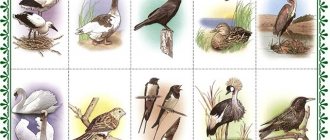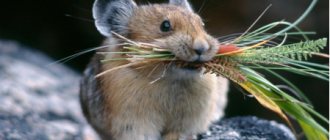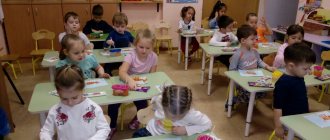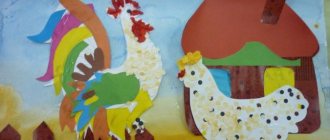Summary of a lesson in the preparatory group of a preschool educational institution. Birds of our city
Lesson notes for preschoolers.
Topic: “Conversation about birds” Objectives of the lesson: Expanding knowledge about the birds of our city. Objectives: to introduce children to the structure of feathers and their significance in the life of birds, to explain the reason for the migration of birds (migratory, wintering, nomadic) to cultivate a caring attitude towards birds; the desire to help birds during a difficult period for them. Preliminary work: bird watching on a walk; looking at illustrations with birds; learning the outdoor game “Birder Catcher”; reading fiction about birds. Equipment: demonstration material “Birds”;
models - diagrams for comparing birds with other animals; feathers of different shapes, colors, sizes; scissors, cups of water; cards for the didactic game “Where do birds winter?”; feeders and various bird food. Progress of the lesson.
Educator: Hello, guys! So autumn has come. What changes have occurred in nature? Children: (list the signs of autumn). Educator : why are there fewer birds? Children: insects disappeared, and birds that feed on insects flew to warmer climes. Educator : Guys, how do birds differ from other animals? Children: (answer based on models - diagrams). Educator : what birds do you know? Children: (list birds). Educator: where do birds fly in the fall? Children: south. Educator : What are the names of the birds that flew south? Children: migratory birds. Educator : What migratory birds do you know? Children: ... Educator: with the onset of cold weather in the fall, the migration of birds begins, this is how it is written about in the poem by E. Blaginina: Soon white snowstorms will raise the snow from the ground. The cranes are flying away, flying away, flying away. You can’t hear the cuckoo in the grove, And the birdhouse is empty, The stork flaps its wings - It flies away, it flies away. A patterned leaf sways in a blue puddle on the water. A black rook and a black rook are walking in the garden, along the ridge. The rare rays of the sun, crumbling and turning yellow, The rooks are flying away, flying away, flying away. Guys, what birds is this poem about? Children: about migratory ones. Educator : the first to fly away from us are the fast-winged birds. These are swifts, swallows, starlings, larks. They fly away at the end of August, because... many insects disappear. These birds feed on insects and are called insectivores. Now your task is to find insectivorous birds? On the golden autumn days, the cranes gathered to fly away. They circled over their native swamp, gathered in schools, and headed to distant warm countries. The strongest one flies ahead - the leader. Wild geese and ducks fly away later than everyone else - when rivers and lakes freeze. These birds are called waterfowl. And again you have a task, find waterfowl? Flocks of birds fly high, and we hear their farewell calls from the sky. It’s as if they are shouting: “Goodbye, see you joyfully in the spring!” And now I propose to play the game “The Birds Have Arrived!”
Birds have arrived: Pigeons, tits, Flies and swifts... (children clap) Educator: What's wrong?
Children: flies. Educator: And who are flies? Children: insects. Educator: you are right. Well, let's continue. Birds arrived: Pigeons, tits. Storks, crows, Jackdaws, pasta!.. (children clap) Teacher : let's start again... Birds have arrived: Pigeons, martens!.. (if the children do not pay attention to the martens, then the teacher announces the score) Teacher: one zero in my favor. Martens are not birds at all. Let's continue... Birds have arrived: Pigeons, tits, lapwings, siskins, ticks, swifts, storks, cuckoos... Even scops owls... (children clap) Teacher: what is it? Not buns, but scoops - scops owls! Birds arrived: Pigeons, tits, Lapwings, siskins, Jackdaws and swifts Mosquitoes, cuckoos... (children clap and say that mosquitoes are insects) Educator: Birds arrived: Pigeons, tits, Jackdaws and swifts, Lapwings, siskins, Storks, cuckoos, Even Owls - Scops Owls, Swans, Starlings... Well done to all of you! Educator: guys, there are feathers on the tables in front of you, look at them carefully. How are feathers different? Children: color, size, shape. Educator : each feather has a rod, guess where the pen's rod is? Show it. The feather also has barbs. Find the beards. Show them. Notice how the barbs are attached to the shaft. Place the feathers on the table. What will happen if the wind blows now? Children: feathers will fly, they are light. Educator: if we cut the feather shaft, we will see that the inside is empty, so the feathers are very light. Dip the pen into a glass of water, is the pen wet, has the pen changed? Children: no, the water rolled down in droplets. Educator : feathers protect the bird from water and dampness. Think about why birds need big feathers? Children: to fly. Educator: why do they need small feathers? Children: for warmth. Educator: now look at the color of the feathers. What can you say? Children: feathers are different colors. They decorate the birds. Educator: You can often meet very beautiful birds. In most birds, only the males are brightly colored. They use their coloration to attract females. Females of the same birds most often have a uniform color, which helps them hide from enemies when they hatch eggs. (the teacher demonstrates birds with bright plumage) Teacher: you are probably a little tired, so I suggest playing the outdoor game “Birder”. The players choose the names of the birds whose calls they can imitate. They stand in a circle, in the center of which is a blindfolded birdcatcher. The birds walk, circle around the bird-catcher and say: In the forest, in the little wood, On the green oak tree, The birds sing merrily. Oh! The bird catcher is coming! The bird catcher claps his hands, the players stop in place, and the driver begins to look for birds. The one he finds imitates the call of the bird he has chosen. The birder guesses the name of the bird and the name of the player. The player becomes a bird catcher. Players should not hide behind objects encountered along the way. Players must stop in place exactly when signaled. Educator: not all birds fly away, there are those that stay with us for the winter. What are their names? Children: wintering, sedentary. Educator : What wintering birds do you know? Children: (list the wintering birds of our region). Educator : I suggest playing the game “Where do the birds winter?” Here are cards with a snowflake on the left and a sun on the right. Your task is to place wintering birds on the left side from the small cards provided, and migratory birds where the sun is. (the teacher checks the task together with the children) Teacher: Well done, guys, you completed the task. Why do they say that winter is a difficult time for birds? Children: (speak out). Educator: how can you take care of them in winter? Children: ... Educator : what can be used as food for birds in winter? Children: ... Educator : Indeed, winter is a difficult time for birds, especially if it is frosty and full of snow.
Birds cannot find food under the snow. A hungry bird suffers greatly from the cold. Winter days are short, and in order to survive without freezing, you need to eat much more food than in summer. You need to support the birds, make feeders for them and don’t forget to bring food to them. This is a very useful thing. Excursion to the winter park “Observation of wintering birds”
Purpose: Observation of birds in nature. Objectives: - consolidate knowledge about wintering birds - form an idea of how wintering birds obtain food - cultivate a desire to care for and protect them. Progress of the excursion Organizational moment: The blizzard has cleared up again, Tearing off the snow caps. The bird is completely frozen and sits with its paws tucked in. The teacher asks the children questions. What birds are called wintering birds? What do they eat? What wintering birds do you know? Why don’t wintering birds fly to warmer climes for the winter? How can a person help wintering birds? — Wintering birds do not fly away from us to warmer climes, since they find food even in winter. They feed on buds, seeds and fruits of plants, hidden insects, and look for food near human habitation. Some birds die from the cold in winter. People can help wintering birds - tits are given unsalted lard, sparrows love millet and seeds. Speech therapist: The snow is fluttering, spinning, it’s white outside and the puddles have turned into transparent glass. In the garden where the finches sang, look today - Like pink apples, there are bullfinches on the branches. Who can say, who knows when this happens? Children: In winter! Speech therapist: That's right, in winter. Anyone who listened carefully to the riddle heard the name of the birds. Which ones? Children: Bullfinches. Educator: What kind of birds are these? How did you guess that it was a bullfinch? That's right, his chest is red. It’s not for nothing that in the riddle it is compared to an apple. Tell me, Miron, about the bullfinch. Guys, who knows what bullfinches eat? (Children's answers). Yes, bullfinches eat rowan berries. What other birds do we see in the park? Children: Crow. Educator: Who wants to tell you about the crow, what is it like? (Children's answers). That's right, the crow is big and gray. What does she eat? Crows collect crumbs and pieces of other food. Children also talk about the magpie, sparrow, and dove. Educator: And this bird is a frequent guest at our feeder. What is it called? Children: - Tit. Educator: Why do you think it is called that? (Children's answers). That's right, because it has a blue tint on its head, wings and tail. Educator: Life is hard for birds in winter. Why don’t they fly to warmer regions, like starlings, rooks, and swallows? Why do they stay? (Children's answers). Everything is correct, because tits, magpies, crows, pigeons, sparrows are wintering birds. They stay with us for the winter to make our lives more fun. Life is difficult for birds in winter, and to make it easier for them to get food, they gather in flocks. How can we help birds in winter? (Children's answers). The speech therapist reads a poem by A. Yashin: Feed the birds in winter! Let flocks of people flock to your porch from all over, like home. It’s hard to see how many of them die in the world. But there is warmth in our hearts for them too. Accustom the birds to your window in the cold, So that we don’t have to greet spring without songs. Dynamic pause: Gray crows flew and sat down at our feeding trough. They pecked, pecked, and jumped around the feeding trough. They all ate the treat and quietly flew away. The speech therapist reads a poem: The paws are getting cold in the cold near the pine and spruce trees. What a miracle - the apples are ripe on the birch tree! I’ll come closer to her, And I can’t believe my eyes - A flock of scarlet bullfinches has stuck around the tree! (I.V. Kravchenko) The teacher conducts a conversation: - Whom does the author compare to ripe apples? (Bullfinches). — Bullfinch are birds. — When do bullfinches come to us? (With the onset of the first frost) - Bullfinches are migratory birds, that is, they move from one place to another over a short distance in search of food, wintering, and rest? — What do bullfinches eat? (Berries of rowan, viburnum, juniper and plant seeds, some insects). - What does a bullfinch look like? (Children's answers) - Yes, guys, the male bullfinch has a bluish-gray back, a dazzling white undertail, a black tail and wings, and a bright red breast. The female is more modestly colored - her breast is not scarlet, but dark gray. - Do you know how bullfinches behave? (Children's answers.) - These birds are slow, clumsy, important, pugnacious, cocky. They slowly fly in small flocks from tree to tree, slowly pecking at rowan berries. -What does a bullfinch whistle sound like? To the sound of a flute: gentle, sad. Listen. (The teacher plays an audio recording of bullfinches whistling) - How can we help these birds in winter? (Children's answers). — The most important rule for humans is not to interfere with nature and take care of our little feathered friends! Without them, our life will become boring and “ugly”. Outdoor game "Bullfinches" Bullfinches. Bullfinches. (Children stand facing in a circle, clapping their hands at their sides). One two Three. One two Three. (They bend three fingers on both hands, starting with the big ones.) They arrived, sat, (They bend the remaining two fingers on each hand.) They made a noise, flew away. (They run in a circle, flapping their arms like wings.) They flew into the sky. (They stop and wave with crossed palms.) What miracles! (They spread their hands in surprise.) - Well done, guys! - And now we will feed the wintering birds. Let's hang a feeder with treats for them. — What shall we treat the birds with? (millet and seeds). -And we also want to tell you about bread crumbs. Bread crumbs freeze in the cold, and when birds start pecking at them, the crumbs can get stuck in the throat and the bird will die. Therefore, it is better not to feed with bread crumbs! — Our excursion has come to an end. But we can still watch wintering birds on the way to kindergarten.
We recommend watching:
Notes on drawing for the preparatory group of kindergarten. Notes on an art lesson on the topic Autumn. Preparatory group Lesson for senior and preparatory groups on the topic: My city Summary of the lesson in the preparatory group. Dymkovo toy
Similar articles:
Conversation in kindergarten on the topic: “Wintering birds” in the preparatory group
Conversation in kindergarten on the topic “Migratory birds” in the preparatory group
A story about a pigeon, grades 1-2. The world
A story about a canary for children, grades 1-2
About migratory birds for children 5-6 years old
Project “Wintering birds of our region” - presentation
MUNICIPAL BUDGETARY PRESCHOOL EDUCATIONAL INSTITUTION KINDERGARTEN 12 “Healthy.” Project “Wintering birds of our region” Author: teacher of the senior group Drugova L.V.
FEED THE BIRDS Feed the birds in winter. Let flocks of people flock to your porch from all over, as if it were home. Their food is not rich. They need a handful of grain, just one handful, and they won’t be afraid of winter. A. Yashin
ABOUT THE PROJECT Type of project: educational and research Project participants: children of the senior group, parents of pupils, teachers of the group Duration of the project: short-term Forms of work: playful, educational, productive, work with parents
Problem: Insufficient understanding of wintering birds among older preschool children.
Relevance In the cold season, wintering birds face the question: how to feed themselves? The available food is becoming significantly less, but the need for it is increasing. Sometimes natural food becomes practically unavailable, so many birds cannot survive the winter and die. And only people can help the birds. When the night temperature drops to -10 degrees or lower, tits lose 10% of their body weight overnight. Hungry, weakened birds quickly freeze. But a well-fed bird is not afraid of frost. So the birds fly closer to human habitation. The task of adults is to cultivate children’s interest in birds, the desire to learn new facts about their lives, and the desire to help them. During the “Wintering Birds” project, children will learn more about birds, find out what birds eat in winter and how to feed them correctly, and learn what bird feeders exist.
Goal: to develop in children a system of basic ecological knowledge about wintering birds and human assistance to nature. Objectives: 1. To develop the ability to distinguish and name wintering birds. 2. Expand your horizons about wintering birds (appearance, habitat, nutrition). 3. Develop children's creative and intellectual abilities. 4. Involve students and parents in this problem.
Stages of project implementation: Stage I - preparatory Stage II - main (practical) Stage III - final
Stage I – preparatory Discussion of goals and objectives with children and parents. Creating the necessary conditions for the implementation of the project. Long-term project planning. Development and accumulation of methodological materials on the problem.
Introduction into the educational process of effective methods and techniques to expand the knowledge of preschoolers about wintering birds. Stage II – basic (practical)
Homework for parents Observation during walks (appearance, habitat, etc.). Make a feeder together with your child. Learn a poem about wintering birds. Find riddles about wintering birds. Look at wintering birds in illustrations in books and magazines. Enrich the group’s library with books about wintering birds.
Contents of work during the project implementation. Game activity Didactic games: “One-many”, “Name it affectionately”, “Counting birds”, “Odd Four”, “Guess the bird by description”, “Whose tail?”, “Who eats what”, “Find out by voice” , “What do birds eat.” N/and "Cut pictures". “Wintering Birds Labyrinth”. Role-playing games: “Bird yard”. Theatricalization: “Where the sparrow dined.”
Outdoor games "Owl". "Sparrows and a car." "Sparrows and the cat."
Cognitive activity Formation of a holistic picture of the world: Topic: “Wintering birds” Goals: developing children’s knowledge about wintering birds, explaining the reasons for their flights (migratory, wintering), developing a caring attitude towards birds.
FEMP: Topic: “How many birds flew to our feeder?” Goal: teaching ordinal and quantitative counting within 10, consolidating knowledge about the sequence of days of the week.
Conversations: “How our feathered friends live in winter.” "Who cares about the birds." “Do birds bring benefit or harm?” "Birds Menu" “How do children and parents take care of birds in winter?”
Solving a problem situation: “What can happen if you don’t feed the birds in winter?” Winter bird watching for tit; behind the crow; for the bullfinch; behind the dove.
Communication Reading stories: I. Turgenev “Sparrow”, M. Gorky “Sparrow” + watching the cartoon, N. Rubtsov “Sparrow” and “Crow”. Sukhomlinsky “What the titmouse is crying about”, viewing presentations: “Wintering birds”, “Feeders”. Creative storytelling: “How I saved a bird.” Memorizing the poem “Feed the birds in winter.” Guessing riddles, looking at illustrations depicting wintering birds.
An exhibition of books and illustrations about wintering birds of our region on a bookshelf.
Artistic creativity Drawing “Wintering Birds” Goal: to develop interest and a positive attitude towards the non-traditional drawing technique - with palms.
Working with parents: Consultations for parents “How and from what you can make a bird feeder.” Assignment for parents: help children choose food for birds.
Stage III - final Formation of the project result in the form of a presentation. Organization and participation of parents in the Bird Feeder event.
Results of the project The children's horizons about wintering birds have expanded (what birds flew to the site, what they look like, what they eat). The group's educational environment was replenished with: literature, photographs, illustrations, poems, stories about birds, riddles, and presentations about wintering birds. Children have developed curiosity, creativity, cognitive activity, and communication skills. The pupils and their parents took an active part in helping the birds in difficult winter conditions.
THANK YOU FOR YOUR ATTENTION!




